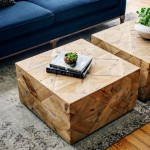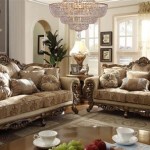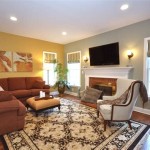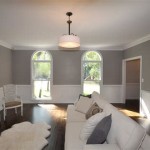Large Living Room Table Lamps: Illumination and Aesthetic Impact
Large living room table lamps serve as more than just sources of light; they are significant design elements capable of influencing the ambiance and functionality of a living space. Their substantial size allows them to command attention, contribute to the room's overall aesthetic, and provide ample illumination. Understanding the characteristics, selection criteria, and placement considerations associated with large table lamps is essential for homeowners and interior designers seeking to enhance the comfort and visual appeal of their living areas.
These lamps offer a practical solution for rooms needing additional light, particularly in areas where overhead lighting is insufficient or undesirable. They also serve as decorative accents, adding personality and style to the room. By carefully considering the size, style, shade material, and base material of a large table lamp, individuals can create a living room environment that is both well-lit and visually engaging.
Illumination and Functionality
The primary function of any lamp is to provide light, and large table lamps excel in this area. Their size typically accommodates larger bulbs, which can generate a greater amount of light than smaller lamps. This is particularly useful in living rooms, where a variety of activities take place, from reading and relaxing to entertaining guests. The increased light output from a large table lamp can sufficiently illuminate a specific area within the room, creating a focused task light or a more diffused ambient glow.
The placement of a large table lamp significantly impacts its effectiveness. Positioning the lamp near a reading chair provides focused illumination for comfortable reading, while placing it on a console table or sideboard can create a welcoming glow that enhances the room's overall ambiance. It is crucial to consider the height of the lamp in relation to the surrounding furniture. The bottom of the lampshade should ideally be at eye level when seated to prevent glare and ensure optimal light distribution. Furthermore, the shade itself plays a crucial role in the quality of light produced. Opaque shades direct light downwards, creating a more focused beam, while translucent shades allow light to filter through, creating a softer, more ambient glow.
The choice of bulb is also a significant factor influencing the illumination provided by a large table lamp. Incandescent bulbs provide a warm, inviting light but are less energy-efficient than alternatives. LED bulbs offer superior energy efficiency and a longer lifespan, and they are available in a range of color temperatures, allowing homeowners to customize the light to their preferences. Halogen bulbs offer a bright, white light that is similar to daylight, making them suitable for tasks that require high levels of illumination. Ultimately, the selection of a bulb should be based on the desired light output, energy efficiency, and color temperature for the specific application.
In addition to their primary function of providing light, large table lamps can also serve as focal points within a room's design. Their substantial size and unique designs can draw the eye and add visual interest to the space. Strategically placing a large table lamp in a prominent location, such as on a mantelpiece or a large side table, can instantly elevate the room's overall aesthetic.
Aesthetic Considerations and Style Compatibility
Beyond their functional role, large table lamps are inherently decorative elements that contribute significantly to the overall style of a living room. The lamp's design, materials, and finish should complement the existing décor and reflect the homeowner's personal taste. A wide variety of styles are available, ranging from classic and traditional to modern and contemporary, ensuring that there is a large table lamp to suit every aesthetic preference.
Traditional living rooms typically feature lamps with ornate bases made from materials such as ceramic, wood, or metal. These lamps often have fabric shades in neutral colors or subtle patterns, creating a sophisticated and timeless look. Conversely, modern living rooms often incorporate lamps with sleek, minimalist designs and materials such as metal, glass, or acrylic. These lamps may feature geometric shapes, bold colors, or unique textures to add a touch of contemporary flair. Transitional living rooms, which blend elements of both traditional and modern styles, can accommodate a wide range of lamp designs.
The size and shape of the lampshade also play a crucial role in the overall aesthetic of the lamp. Drum shades offer a clean, modern look, while empire shades provide a more traditional and elegant feel. The shade material can also influence the lamp's appearance. Linen shades create a soft, diffused light, while silk shades offer a more luxurious and sophisticated look. The color of the shade can also be used to complement the room's color palette or to add a pop of color.
The base material of the lamp significantly contributes to its style and durability. Ceramic bases offer a wide range of design options, from simple and understated to ornate and intricate. Wood bases provide a warm, natural feel and can be stained or painted to match the room's décor. Metal bases offer a sleek, modern look and are often available in a variety of finishes, such as brushed nickel, polished chrome, or antique brass. Glass bases offer a transparent and elegant look, allowing the light to shine through and create a luminous effect.
When selecting a large table lamp, it is important to consider the size and scale of the room. A lamp that is too small can get lost in a large space, while a lamp that is too large can overwhelm a smaller room. As a general rule, the height of the lamp should be approximately one-third to one-half the height of the furniture on which it is placed. The width of the lampshade should also be proportionate to the size of the furniture. By carefully considering the size, style, and materials of a large table lamp, individuals can create a cohesive and visually appealing living room environment.
Placement and Space Considerations
The placement of a large table lamp within a living room is crucial for both its functionality and its aesthetic impact. Careful consideration should be given to the lamp's location, its proximity to other furniture, and its contribution to the overall flow of the room.
A common placement for large table lamps is on either side of a sofa or loveseat. This creates a balanced and symmetrical look, while also providing ample light for reading or conversation. The lamps should be positioned at a height that allows the bottom of the lampshade to be at eye level when seated, to prevent glare and ensure optimal light distribution. The distance between the lamps should be roughly equal to the width of the sofa or loveseat, to create a cohesive and balanced appearance.
Another popular placement option is on a console table or sideboard. This can add a touch of elegance and sophistication to the room, while also providing a source of ambient light. The lamp should be positioned towards the center of the table, to create a focal point and to prevent it from being knocked over. The height of the lamp should be proportionate to the size of the table, ensuring that it does not overwhelm the space.
Large table lamps can also be used to highlight specific architectural features within the room, such as a fireplace or a bookcase. Placing a lamp on a mantelpiece can draw attention to the fireplace and create a warm and inviting atmosphere. Placing a lamp on a bookcase can highlight the books and create a cozy and intellectual ambiance. In these cases, it is important to consider the size and style of the lamp in relation to the surrounding features, ensuring that it complements the overall design.
In addition to their placement on furniture, large table lamps can also be used as standalone accent pieces. Placing a lamp in a corner of the room can create a soft and inviting glow, while also filling an otherwise empty space. Placing a lamp on a pedestal or stand can elevate it to a more prominent position, allowing it to serve as a focal point within the room. When using a large table lamp as a standalone accent piece, it is important to consider its size and style in relation to the surrounding décor, ensuring that it complements the overall aesthetic.
Ultimately, the placement of a large table lamp should be based on the specific needs and preferences of the homeowner. By carefully considering the lamp's location, its proximity to other furniture, and its contribution to the overall flow of the room, individuals can create a living room environment that is both well-lit and visually appealing. Proper placement ensures the lamp effectively delivers its intended light output and contributes positively to the room's overall ambience and design.

Ballam Large Table Lamp Art Deco Abigail Ahern

Buy Ivory Cream Moreton Large Table Lamp From The Next Online Shop

Shopping For Table Lamps The New York Times

Large Black Lacquered Table Lamp Juliettes Interiors

Socorro Southwest 26 1 2 Rustic Broe Finish Large Jar Table Lamp 3k680 Lamps Plus

Large Table Lamps For Living Room Blueskyhome

Laura Ashley Carson Large Table Lamp Antique Brass Crystal Amos Lighting Home

Oversized Mercuried Glass Table Lamp

Gold Hammered Led Table Lamp Large Living Room Lounge Light Fabric Shade Bulb Ebay

Our Favorite Living Room Lamps Where To Buy Them








